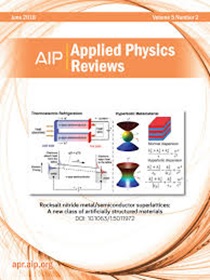Two-dimensional carbide and nitride (MXene) materials for healthcare monitoring and biosensing applications
IF 11.6
1区 物理与天体物理
Q1 PHYSICS, APPLIED
引用次数: 0
Abstract
The rapid evolution of intelligent manufacturing and personalized healthcare has driven demand for high-performance, adaptable sensors. MXenes, a family of two-dimensional transition metal carbides/nitrides, have emerged as transformative materials for next-generation sensing due to their exceptional conductivity, tunable surface chemistry, and versatile nanostructuring capabilities. To advance MXene-based sensing technologies and to facilitate their large-scale implementation at the microsystem or Chip level, this review delves into the latest advancements in MXene-based sensors, emphasizing synthesis strategies that enhance performance—such as HF-free etching and delamination techniques—and their direct impact on sensitivity, selectivity, and stability. Subsequently, MXene-based sensors are categorized into films, hydrogels, aerogels, quantum dots, and fibers from a materials science perspective, highlighting their unique advantages in wearable healthcare monitoring, environmental sensing, and smart industrial systems. Looking ahead, the primary challenges and future prospects for MXene sensors, including artificial intelligence-driven multifunctional platforms and scalable roll-to-roll fabrication, are provided, along with an assessment of their potential to accelerate commercialization in the near future.用于医疗监测和生物传感应用的二维碳化物和氮化物(MXene)材料
智能制造和个性化医疗的快速发展推动了对高性能、适应性强的传感器的需求。MXenes是一类二维过渡金属碳化物/氮化物,由于其优异的导电性、可调的表面化学性质和通用的纳米结构能力,已成为下一代传感的变革性材料。为了推进基于mxene的传感技术,并促进其在微系统或芯片水平上的大规模实施,本文深入研究了基于mxene的传感器的最新进展,强调了提高性能的合成策略,如无高频蚀刻和分层技术,以及它们对灵敏度、选择性和稳定性的直接影响。随后,从材料科学的角度将基于mxene的传感器分为薄膜、水凝胶、气凝胶、量子点和纤维,突出了其在可穿戴医疗监测、环境传感和智能工业系统中的独特优势。展望未来,MXene传感器的主要挑战和未来前景,包括人工智能驱动的多功能平台和可扩展的卷对卷制造,以及它们在不久的将来加速商业化的潜力的评估。
本文章由计算机程序翻译,如有差异,请以英文原文为准。
求助全文
约1分钟内获得全文
求助全文
来源期刊

Applied physics reviews
PHYSICS, APPLIED-
CiteScore
22.50
自引率
2.00%
发文量
113
审稿时长
2 months
期刊介绍:
Applied Physics Reviews (APR) is a journal featuring articles on critical topics in experimental or theoretical research in applied physics and applications of physics to other scientific and engineering branches. The publication includes two main types of articles:
Original Research: These articles report on high-quality, novel research studies that are of significant interest to the applied physics community.
Reviews: Review articles in APR can either be authoritative and comprehensive assessments of established areas of applied physics or short, timely reviews of recent advances in established fields or emerging areas of applied physics.
 求助内容:
求助内容: 应助结果提醒方式:
应助结果提醒方式:


